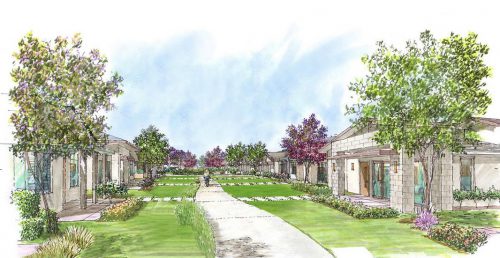
The Social Services Commission on Monday will hear about the affordable housing plan for the proposed West Davis Active Adult Community project, which includes 332 for-sale units along with 150 affordable senior apartments on a 75-acre parcel north of Covell Boulevard and west of Sutter Davis Hospital.
Approval of the project would require a General Plan Amendment, and voter approval under Measure R. Eighty percent of the units, including the affordable apartments, are proposed to be entitled as a senior citizen housing development. The remaining 20 percent of the units (approximately 76 units) would not have age restrictions.
The developers are identifying a 4.25-acre portion of the site that would be designated as senior affordable housing. According to staff, “The 150 units that could be accommodated on the site would likely be built in two phases, depending on financing.”
The identified developers for that portion would be Delta Senior Housing Communities and Neighborhood Partners with the concept modeled after Eleanor Roosevelt Circle on 5th Street.
Staff calculates the affordable housing obligation for West Davis Active Adult Community as 64 units, based upon inclusionary percentages in the Affordable Housing Ordinance. However, they 
suggest, “The exact requirement is likely to shift slightly as the project is revised through the public review and tentative mapping processes.”
Thus the 150 affordable units greatly exceeds all obligations under the ordinance. Staff notes, “Although the site is not proposed to be deeded to the City, it does meet the requirements for a land dedication parcel: minimum of two acres, of sufficient size to meet the required number of affordable units, and without abnormalities in shape and terrain.”
The unit yield for a standard land dedication assumes a density of 15 units per acre. Staff writes, “Even at this relatively low density, the site would receive credit for 64 units and meet the obligations for WDAAC.”
The affordable units are anticipated to be age-restricted, for residents 62 and over.
Staff continues: “This is the customary age restriction for housing subsidies for senior developments. The applicant calculates that the Affordable Housing Ordinance requires the majority of the required affordable units would be rented to households whose incomes do not exceed 65 percent of the Yolo County median income, while a few of the affordable units would have rents affordable to households whose incomes do not exceed 40 percent of the Yolo County median income. Depending upon project financing, rents and incomes might be lower than required by the City.”
Staff also writes that, because the affordable component is targeted to seniors, the staff anticipates that the city “would allow deviation from the standard requirement for a mix of two- and three-bedroom units.”
This is the second time that the project has been before the Social Services Commission, with the first time being in March where the commission heard a presentation on the proposal and was able to ask questions about the concept. At that time the commission took no formal actions.
One commissioner suggested the need for integration of the affordable housing residents with the homeowners with respect to the use of the amenities in the development.
The applicant responded that the neighborhood will have a large amenity that is open to the general public.
However, the activity and wellness center would be privately owned and, thus, “anyone who wants to use this facility will need to pay whether they live in the neighborhood or live outside of the neighborhood.
The applicant stated: “Importantly, the structure for access will not be similar to a country club. For example, the restaurant will be open to the public. The health club is open to the general public but everyone will need to pay for use. Meeting rooms and classes will be organized for general public access and there may or may not be a cost associated for their use depending on the sponsoring organization.”
He added, “It is not possible to add a fee for full access to the activity and wellness center for the affordable apartment residences as this would change the eligibility requirements.”
—David M. Greenwald reporting







It is still unclear if this development will generate property tax for the City or will it be tax exempt?
The affordable component of 160 units will be tax exempt, but not the for sale units.
Not adds the developer: Low-income elders who cannot afford a car will be dependent on inadequate supply of shuttles and public transportation to get places Downtown. It would be cheaper and obviously in all ways more healthy for them to live in or within walking distance of Downtown, but we hope that the Commission meeting at the edge of Downtown in the single story building surrounded by a huge parking lot does not consider this.
Unitrans is amazingly accommodating. They provide transit for junior high and high school students and would very likely add stops for any senior housing. But previous senior housing developments have generally provided their own shuttle services for residents as well.
Unitrans already has the P-Q route… with an existing shelter @ the NW corner of Covell & Shasta/Risling. Headways are frequent.
The Q is the only direct route with no transfers and minimal walking from that stop. Unless a stop is added within the complex, one has to walk all the way to or from Covell – and cross the wide fast road if headed Downtown – door-to-door to or from Downtown will take at least an hour.
Shuttles will be quicker, but how will they be organized? The City of Davis organizes travel training for Davis elders so they can use the bus. But it should not be because they have to use the bus. Would Unitrans really reduce headways without any other demand? Do we want elders to be segregated to and from Downtown or elsewhere? How much does it cost to keep a driver available for the shuttle seven days a week? How many from the two existing retirement communities currently travel by bus to Downtown? How many cycle?
As always, motor vehicle transportation of any type is an inadequate solution for bad planning. My guess is that many elder would like to live within walking distance or short cycling distance of a Downtown no longer optimized for automobiles, where crossing the street is just a safe as walking on the sides of it.